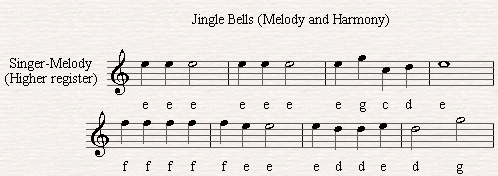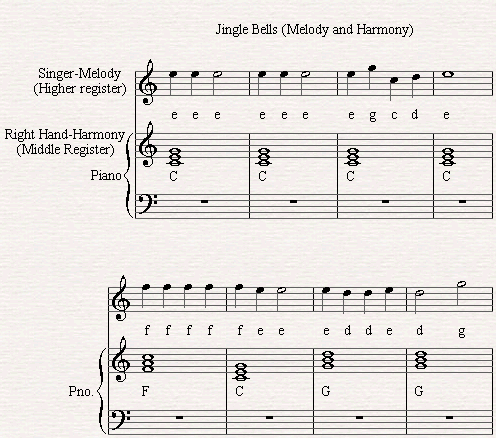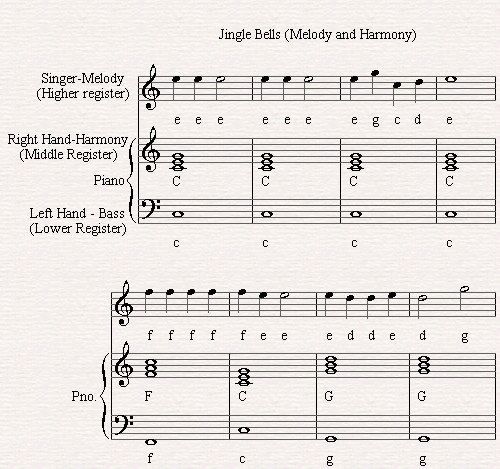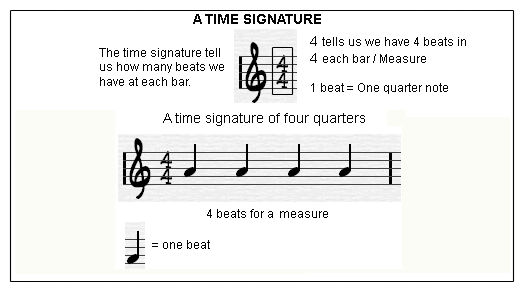How to Play Piano Chords (What to do with the right and left hand)
Home » Accompaniment Course (Level 2) » How to Play Piano Chords
By now you should know how to play the three main chords we covered which are C major, F major and G major. But how are we going to take these and learn how to play the piano by chords while accompanying a song? Or while playing the melody and the harmony of a song?
First let's define the musical function that exists in music.
How to Play Piano Chords with the 3 Important Elements in Music
The Melody:
The melody is the tune of a song. It is the most dominant aspect of a song. It could be sung by a singer or be played by a solo instrument such as a saxophone, a flute, electronic guitar etc... The melody is made of a succession of tones which are arranged in a way that makes sense to us.

When we play piano we will usually play the melody in the higher register of the piano with the right hand where the higher and sharp notes will allow it to stand out and be clearly heard above the harmony and bass since it is the most dominant element of a song.

We're not going to play the melody at this point since I need to show you a few new technical and theoretical skills first. Right now we're going to focus on learning how to play piano chords in order to accompany a song while we or another singer sings the the melody or we simply imagine it in our heads.
The Harmony
As I explained in the previous piano lessons, chords are related to each other. Harmony is basically the chords and their relationship.
Remember that chords are a combination of notes that are sounded simultaneously. So if a chord has three notes you can also say it has three voices. The harmony supports the melody and helps us to accompany and enrich a tune. Practically speaking, the chords will mostly share common notes with the melody in order to support it. They go hand in hand.
The harmony is played mostly under the melodic line in the middle register of the piano.

The Bass
The bass is the lowest part of a musical composition. It is also the second most important element in music since it tells us how a chord functions in a musical passage. We will learn about these functions in the future.
You already learned that when we build a chord we start from the lowest note which we define as the root of the chord or the bass note and we build the rest of the intervals upon this note.
When we would like to learn how to play piano chords in order accompany a song we will play the bass note on the lower register of the piano with the left hand. The lower notes of the piano have lots of depth.
The bass and the melody also define the range of a song so the harmony will be played between those two elements and will react to them both.

So how to play piano chords in order to accompany a song?
In the next few piano tutorials we're going to play the chords with the right hand in the middle register and the bass note with the left hand in the lower register of the piano. We will sing or imagine the melody of a song while we do it.
The Rhythm
To make a long story short, music has beats just like heart beats.
All the beats are equal to each other and they help us to measure the length of a note or a chord in our case.
Therefore we'll be counting beats as we learn how to play piano chords.
The beats are divided in equal groups. Every for beats or sometimes three beats
make a group and we call it a bar.
When you will take a look at the piano tutorial or at any piano
tab you wiill see that a bar line appears after every four beats (or three sometimes).
The bar line states the end of a bar and the beginning of a new one.
The time signature of a song will be defined at the beginning of our piano tutorials and our piano tabs.

 People want to learn how to play chords in order to be able to play any song they desire easily.
Some find it easy to learn how to form new chords but don't know how to take the next step to
combine them in a song, moving smoothly from one chord to the other while playing the rhythm at the same time
People want to learn how to play chords in order to be able to play any song they desire easily.
Some find it easy to learn how to form new chords but don't know how to take the next step to
combine them in a song, moving smoothly from one chord to the other while playing the rhythm at the same time
Some like to imitate what they see on a video but you can learn how to form all possible amazing piano chords and learn to play an enormous amount of different styles like Pop, Rock, Blues, Jazz and more while playing popular songs by artists like the Beatles, Adele, Bruno Mars, Leonard Cohen and more.
Check out our complete "Piano by chords" course where you'll go through a journey that combines both piano lessons and piano tutorials that will make you play the piano like a PRO!
Click here to check out the Piano by Chords Learning Kit Now!














